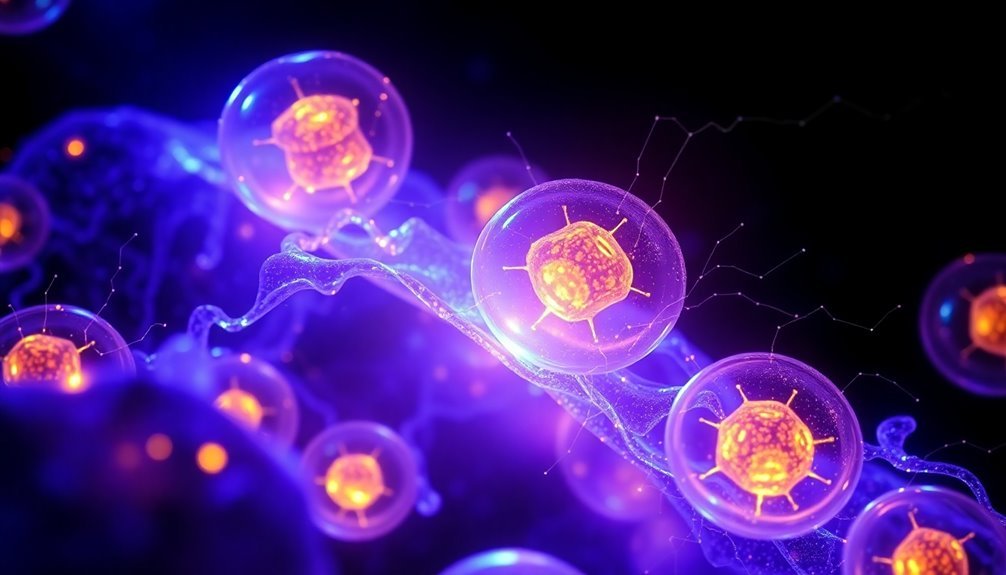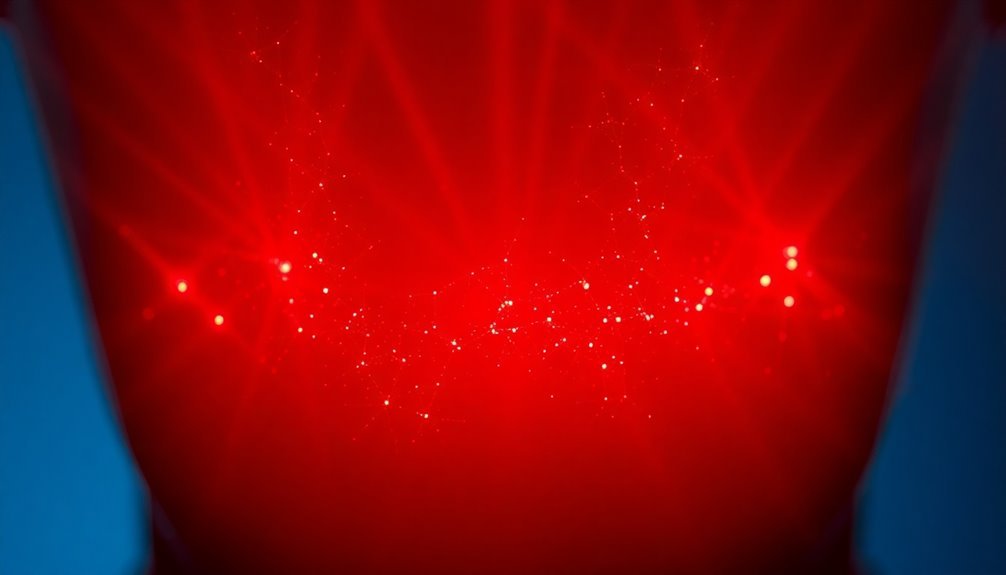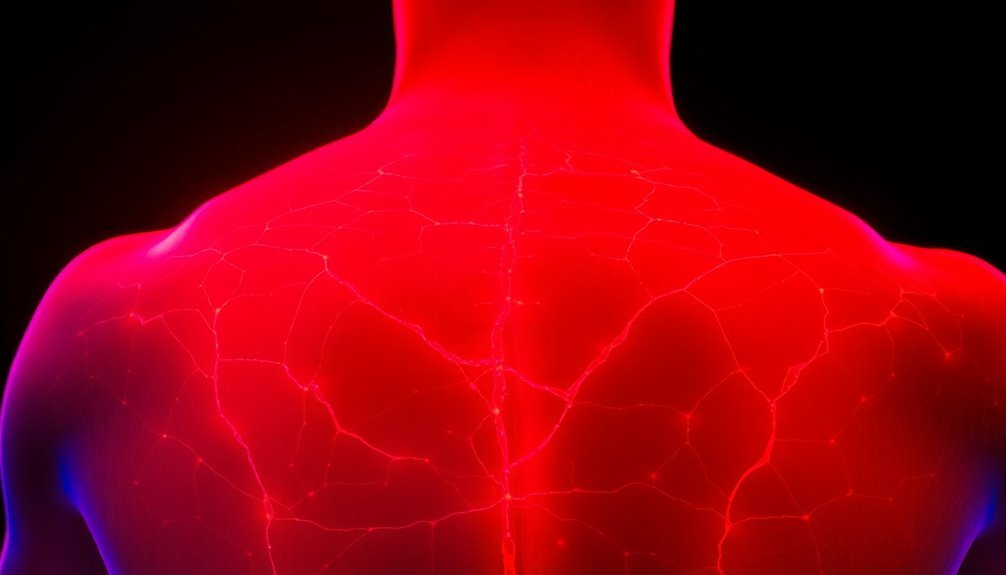Deep rays of red and near-infrared light penetrate your skin to reactivate your body's natural healing abilities at the cellular level. These specific wavelengths stimulate your mitochondria – tiny cellular powerhouses that produce ATP energy through a protein called cytochrome c oxidase. This boost in cellular energy triggers a cascade of healing responses: increased collagen production, enhanced blood flow, and reduced inflammation. Your body responds by accelerating tissue repair, reducing pain, and regenerating damaged cells. This non-invasive therapy works with your body's own mechanisms to promote healing, and modern research continues to uncover its remarkable therapeutic potential.
Deep Rays Transform Cellular Health

Anyone seeking natural healing solutions should consider the transformative power of deep rays on cellular health. Unlike radiofrequency radiation, which can damage DNA, infrared radiation (IR) and red light therapy offer therapeutic benefits while protecting your cells.
These deep rays stimulate cellular regeneration and boost collagen production, leading to healthier, more resilient tissue.
You'll find that deep rays work at the molecular level to enhance your body's natural healing processes. When exposed to high-intensity red and near-infrared LEDs, your oxygen-deprived wounds heal faster, while your skin, bone, and muscle cells multiply more effectively.
The therapeutic doses of IR provide photoprotective properties that shield you from UV radiation's harmful effects.
Recent studies have shown that long-term exposure risks need careful consideration when choosing therapeutic radiation treatments.
What makes deep rays particularly effective is their ability to trigger systematic healing through multiple phases, including hemostasis, inflammation, proliferation, and maturation.
Your fibroblasts, which are essential for skin remodeling, respond positively to this therapy by producing essential components of the extracellular matrix and releasing growth factors.
Through these mechanisms, you're not just treating surface-level issues – you're activating your body's innate regenerative capabilities at the cellular level.
Mitochondria Power Skin Repair
Your skin's natural healing power relies on mitochondria, the cellular powerhouses that generate the ATP energy needed for repair and regeneration.
When deep rays penetrate your skin, they stimulate these microscopic energy factories to boost ATP production, providing the fuel necessary for cellular repair processes.
This enhanced mitochondrial activity drives collagen synthesis and accelerates healing, helping your skin rebuild and restore itself more effectively. Your skin achieves optimal restoration through calcium homeostasis regulation managed by these vital cellular components.
Cellular Energy Drives Healing
Three powerful engines drive the skin's natural healing process: mitochondria, ATP production, and cellular energy. These microscopic powerhouses generate the fuel your skin cells need to repair and regenerate. When your skin's energy production functions at its best, it maintains homeostasis and supports rapid cell proliferation essential for healing.
Your skin's repair mechanisms depend heavily on ATP, which mitochondria produce through cellular respiration. This energy enables keratinocytes to differentiate properly and allows epidermal stem cells to activate when needed for wound healing. The temporary suppression of MPC1 can actually enhance stem cell activation and improve skin repair capabilities.
| Energy Source | Function | Impact on Healing |
|---|---|---|
| Mitochondria | ATP Generation | Powers cell repair |
| ATP Production | Cell Energy Supply | Enables regeneration |
| Cellular Respiration | Oxygen Utilization | Supports differentiation |
| ROS Signaling | Cell Communication | Triggers repair response |
You'll find that your skin's healing capacity directly correlates with its mitochondrial health. When mitochondrial function declines, you'll experience slower healing and increased aging signs. However, by supporting mitochondrial activity, you can enhance your skin's natural repair processes and maintain its regenerative abilities through proper cellular energy production.
Light Activates ATP Production
Specific wavelengths of light penetrate the skin to trigger a remarkable cellular response in mitochondria, boosting ATP production and accelerating healing. When light reaches your cells, it activates cytochrome C, a vital protein that absorbs light at specific wavelengths (440, 520, and 550 nm), enhancing your body's natural ATP production process. Research shows that energy transfer mechanisms enable both direct and indirect mitochondrial photo-activation.
Different light wavelengths offer unique benefits for your skin's health. Red light (630-700 nm) reduces inflammation and improves skin tone, while blue light (400-450 nm) targets acne-causing bacteria and helps regulate oil production.
Near-infrared light penetrates deeper, promoting wound healing and reducing inflammation at cellular levels. You'll find that amber light (570-620 nm) enhances your lymphatic flow and cellular function.
Your mitochondria respond to this light therapy through a process called photobiomodulation, where chromophores absorb light and initiate cellular signaling. This activation can boost healing rates by up to 50% and substantially reduce inflammation.
The enhanced ATP production powers various cellular processes, including repair mechanisms and survival pathways, making light therapy an effective treatment for skin conditions, wound healing, and managing cancer treatment side effects.
Collagen Synthesis Through Mitochondria
Beyond light-driven ATP production, mitochondria power the remarkable process of collagen synthesis in your skin cells. Your fibroblasts, the primary drivers of wound healing, depend on mitochondrial energy to produce collagen and maintain your skin's firmness and elasticity. Declining NAD+ levels with age directly impacts mitochondrial efficiency and collagen production.
When mitochondria function at their best, they support the complex transformation of collagen III into collagen I during tissue remodeling, while also protecting against oxidative stress that can damage existing collagen.
- Mitochondrial energy fuels the continuous production of collagen, keeping your skin plump and youthful
- Your skin's repair process relies on mitochondria-powered fibroblasts to create new tissue
- Healthy mitochondria combat oxidative stress that would otherwise break down collagen
- During wound healing, mitochondrial function increases to support enhanced collagen synthesis
- Properly functioning mitochondria maintain cellular energy balance for consistent collagen production
Your skin's ability to maintain its structure depends heavily on mitochondrial health. When mitochondria become dysfunctional, collagen synthesis decreases, leading to fine lines, wrinkles, and reduced elasticity.
Supporting mitochondrial function through targeted treatments can enhance your skin's natural collagen production and promote effective healing.
Collagen Production Through Light Therapy

Light therapy's breakthrough role in collagen production has revolutionized skin rejuvenation treatments. Using specific wavelengths between 630-850 nm, this therapy targets your skin's fibroblasts, the cells responsible for producing collagen.
You'll find that dual-wavelength combinations of 635 nm and 830 nm are particularly effective at stimulating these cells and enhancing collagen synthesis. This scientific approach is completely pain-free and requires no recovery time.
When you undergo LED light therapy, the red and near-infrared rays penetrate deep into your skin layers, activating your mitochondria to produce more ATP. This increased energy production powers your fibroblasts to create new collagen fibers.
You'll notice that the therapy also boosts your blood flow, which helps deliver essential nutrients while removing toxins from your skin cells.
Clinical studies show you can expect significant improvements in skin elasticity and wrinkle reduction after multiple sessions. In fact, 87% of patients see a measurable decrease in wrinkle severity after completing 12 treatments.
While you won't see instant results, this non-invasive approach effectively treats various skin concerns, from sun damage to mild acne, by stimulating your body's natural collagen-producing mechanisms.
Blood Flow Speeds Healing
Ever wonder how your body accelerates its natural healing process? When exposed to infrared and red light therapy, your blood vessels dilate through the release of nitric oxide from hemoglobin molecules.
This dilation creates a powerful healing cascade that delivers more oxygen and nutrients to damaged tissues. Twenty minute treatments are typically sufficient to achieve therapeutic benefits.
- Your mitochondria produce more ATP, energizing cellular repair
- Blood vessels expand, allowing increased circulation to injured areas
- Inflammation levels balance naturally, speeding recovery
- Oxygen-rich blood reaches damaged tissues more effectively
- Natural healing processes activate without medication side effects
You'll experience faster healing when your blood flow improves through light therapy. The science shows that enhanced circulation doesn't just speed up wound healing – it also supports surgical recovery and improves cardiac function.
This therapy's ability to boost blood flow has been proven in numerous clinical studies, particularly when combined with other treatments like PEMF therapy. Your body responds by healing wounds more quickly, reducing pain, and improving overall tissue health.
For cardiac patients, the benefits extend to better left ventricular function and improved myocardial contractility. It's a natural approach that works with your body's own healing mechanisms to achieve ideal results.
Managing Pain With Light

Three powerful mechanisms make light therapy an effective tool for managing chronic and acute pain. When light energy penetrates your tissue, it triggers cellular metabolism, stimulates nitric oxide release, and activates pain-relieving pathways. These processes work together to reduce inflammation while promoting natural healing. The specialized use of green light exposure has demonstrated remarkable success in reducing migraine frequency and intensity.
You'll find that light therapy offers a drug-free alternative to traditional pain management, with clinical trials showing up to 50% pain reduction in conditions like fibromyalgia and migraines.
| Condition | Light Therapy Benefits |
|---|---|
| Arthritis | Reduces inflammation and joint pain |
| Back Pain | Increases tissue regeneration |
| Knee Pain | Improves mobility and function |
| Fibromyalgia | Enhances sleep and quality of life |
Your body's natural healing response is enhanced as light therapy increases blood flow and oxygen delivery to affected areas. Unlike medications that mask symptoms, light therapy addresses the underlying causes of pain. Whether you're dealing with acute injuries or chronic conditions, photobiomodulation therapy can help reduce healing time and decrease your reliance on pain medications. As research continues, new applications and more efficient delivery methods are being developed to make this treatment even more effective.
Light Technology Reshapes Modern Medicine
Through groundbreaking advances in medical technology, deep-body illumination is revolutionizing how doctors treat complex diseases. The innovative Endovascular Therapy-Based Light Illumination Technology (ET-BLIT) now allows physicians to deliver targeted light therapy deep within your body using specialized catheters and transparent tips that can rotate towards specific lesions. Doctors can measure treatment effectiveness by tracking cellular ATP production, since laser therapy enhances energy production in cells.
- Precise light delivery through blood vessels reaches previously inaccessible areas
- Customizable wavelengths stimulate cellular repair and natural healing
- Minimal side effects compared to traditional treatments
- Treatment options for cancer, hereditary conditions, and protein disorders
- Integration with existing endovascular procedures for enhanced efficiency
You'll find this technology particularly promising because it combines photodynamic and photobiomodulation therapies to trigger your body's natural healing responses.
The light activates chromophores in your tissues, stimulating mitochondria and hemoglobin to enhance cellular repair. While you might feel mild warmth during treatment, the benefits are cumulative and can include reduced inflammation, improved circulation, and enhanced tissue healing.
This versatile approach isn't just transforming pain management – it's opening new possibilities for treating chronic conditions like osteoarthritis and fibromyalgia, making it a cornerstone of modern medical innovation.
Frequently Asked Questions
Can Deep Ray Therapy Interact Negatively With Certain Medications or Supplements?
Yes, you'll need to be careful with medications like tyrosine kinase inhibitors and seizure drugs during deep ray therapy. Always tell your doctor about any medications or supplements you're taking to avoid dangerous interactions.
What Is the Recommended Frequency and Duration for Red Light Therapy Sessions?
You'll want to start with three 20-minute sessions per week. You can gradually increase to daily sessions as your body adjusts. Don't exceed 20 minutes per session, and maintain consistency for best results.
Are There Specific Skin Conditions Where Red Light Therapy Should Be Avoided?
You shouldn't use red light therapy if you have photosensitivity, lupus, open wounds, or active skin infections. It's also best to avoid treatment if you're taking medications that increase light sensitivity.
How Long Do the Benefits of Deep Ray Treatment Typically Last?
You'll typically experience radiation treatment effects for several months to years. The duration varies based on your specific condition, treatment area, and overall health. Regular follow-up appointments help monitor long-term benefits.
Can Deep Ray Therapy Be Safely Combined With Traditional Cancer Treatments?
You can safely combine deep ray therapy with traditional cancer treatments like chemotherapy and surgery. It's often used before or after surgery and alongside chemo to enhance overall treatment effectiveness and target remaining cancer cells.
In Summary
You've witnessed how deep ray therapy taps into your body's innate healing abilities. Through enhanced mitochondrial function, increased collagen production, and improved blood flow, you're activating cellular repair naturally. Whether you're managing pain or seeking skin rejuvenation, light-based treatments are revolutionizing your healthcare options. As science continues revealing light's therapeutic potential, you'll find more ways to harness its healing power.





Leave a Reply